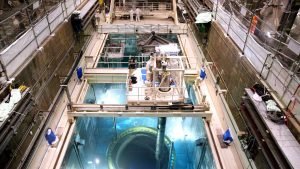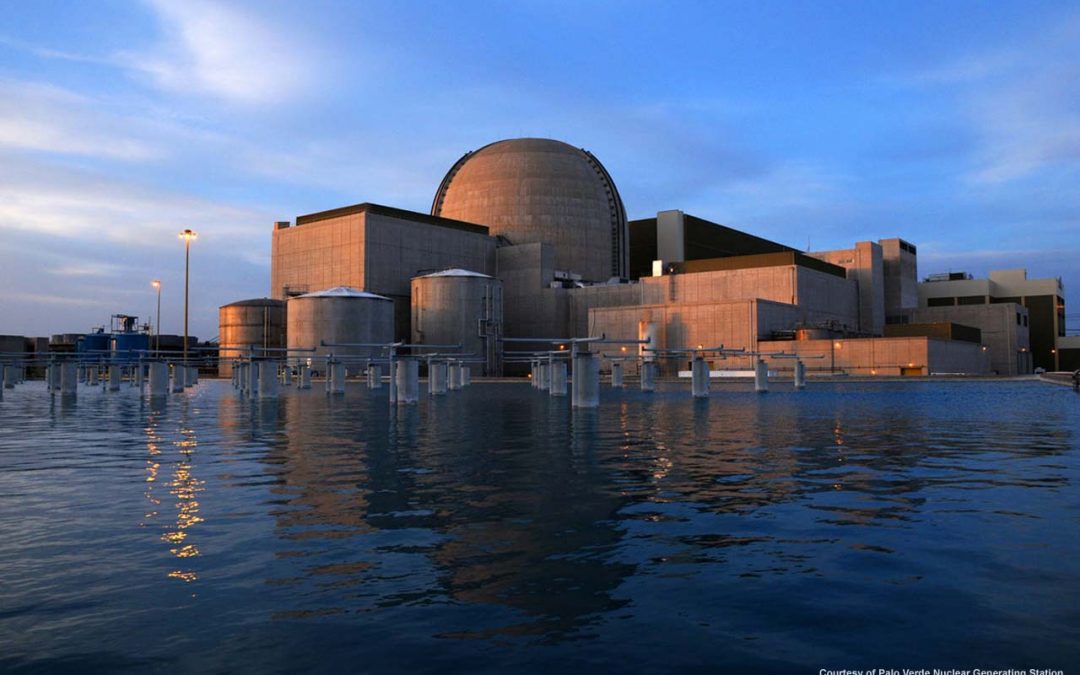Palo Verde Nuclear Generating Station in Arizona
By James Conca,
Lately, there have been some cool articles on the largest power plants in the world (Forbes – Pentland), and China always tops the chart with its Three Gorges Dam Hydroelectric Plant. Of course, the U.S. has some pretty big ones that make it into the top tier.
But everyone uses the wrong measure to decide what’s the biggest power plant.
The usual measure of what’s bigger is the so-called Nameplate installed capacity, which is the maximum power a plant can produce when everything is running perfectly. The Grand Coulee Dam in Washington State has a Nameplate capacity of 6,809 MW (megaWatts), the biggest in America.
But the real measure is what the power plant actually produces over the year. The difference between these two measures is what’s known as the capacity factor (cf). The cf is equal to what the plant, array or farm produces in kilowatt hours (kWhs) per year divided by what it could produce if it ran at capacity, 24 hours a day, every day for the entire year. (A year has 8,766 hours, and we like to use kWhs for production since that’s what shows up in everyone’s electric bill at the end of the month.)

Palo Verde Nuclear Generating Station in Arizona produces the most electricity of any power plant in America, over 30 billion kWhs per year. In 2014, it ran almost 24-7, with a capacity factor of 98% (cf = energy actually produced divided by the maximum possible). No other energy source but nuclear approaches a cf of 90%, and most are under 50%. Source: NEI
However, no power plant runs all the time. There are outages for refueling, maintenance, and accidents. Often the sun isn’t shining or the wind isn’t blowing. Sometimes the regional transmission organization asks a power plant to ramp down for some other reason. Sometimes the hydroelectric dams are overflowing and we need to use them instead of a local coal plant so we don’t lose that energy over the top of the dam.
Thus, the Grand Coulee Dam, with a Nameplate installed capacity of 6,809 MW, should be able to generate:
6,809 MW x 1,000 kW/MW x 8,766 hours/year = 59,687,694,000 kWhs/year
Instead, last year Grand Coulee only produced 20,266,322,000 kWhs, giving it a cf of 34% for 2014. Usually Grand Coulee has a higher cf but low snowpack, drought and planned maintenance made it a bit lower than usual.
Compare that with the Palo Verde nuclear plant in Arizona, which has a Nameplate installed capacity of only 3,747 MW. If Palo Verde ran 24-7, it should be able to produce
3,747 MW x 1,000 kW/MW x 8,766 hours/year = 32,846,202,000 kWhs/year
In 2014, Palo Verde produced 32,320,917,000 kWhs, 60% more than Grand Coulee, and more than any other power plant in America. All because Palo Verde had a cf of 98%, one of the largest capacity factors in history.
The capacity factor is where nuclear power excels, it’s almost always about 90%. And it’s why the most productive power plants in America are nuclear. So let’s look at average capacity factors and find out which power plants in America rank in the top ten.
The average capacity factor (cf) for the common energy sources are as follows along with values for the few times they’ve been extraordinarily high (EIA; Earth Policy Institute; The Energy Collective; among others):
Energy Source average cf high cf
Coal 65% 75%
Natural gas 50% 85%
Nuclear 90% 98%
Wind 30% 45%
Solar PV 20% 30%
Solar thermal 24% 40%
Hydro 40% 45%
Geothermal 70% 75%
Since nuclear’s cf is so high, it is likely that the most productive plants in America will be nuclear, which is exactly the case. In 2014, the following ten power plants produced the most electricity in America:
Palo Verde Nuclear Station 32,846,202,000 kWhs
Browns Ferry Nuclear Station 26,738,300,000 kWhs
Oconee Nuclear Generating Station 21,193,381,000 kWhs
South Texas Project Nuclear Station 20,651,667,000 kWhs
Grand Coulee Hydroelectric Station 20,266,322,000 kWhs
Braidwood Nuclear Station 20,263,665,000 kWhs
West County Energy Center (NGCC) 19,764,922,000 kWhs
Byron Nuclear Generating Station 19,252,381,000 kWhs
Limerick Nuclear Generating Station 19,077,244,000 kWhs
Scherer Coal-fired Power Plant 18,894,546,000 kWhs

Grand Coulee Dam, usually claimed as the largest power plant in the United States with a Nameplate capacity of 6,809 MW, produces 20 billion kWhs per year, making it only the fifth largest behind four nuclear plants. The largest is the Palo Verde nuclear station which produces over 30 billion kWhs per year with a Nameplate capacity of only 3,747 MW. The secret is in the capacity factor. Source: BPA
Notice that Grand Coulee drops to fifth place. Only three of the top ten are not nuclear power plants – one hydro, one gas and one coal. And most of the next ten are nuclear as well.
These large power plants, and the next few dozen, are critical to the lives and livelihoods of 100 million Americans. Out of almost 5,000 power plants in this country, these few large ones provide an overwhelming amount of power to America, and are located in critical areas that support the biggest population centers in the country.
It’s nice that most Americans don’t have to worry about whether their lights will turn on when they flip the switch, or that their cell phones will charge without having to do anything more than remembering to plug it in.
But 1.6 billion people have no access to electricity whatsoever. 2.4 billion people still burn wood and manure as their major source of energy. In many places throughout the world, electricity only occurs for a few hours a day, even in cities of 10 million people.
If we are to give these people a good life that only access to energy provides, we should first think about how we give it to ourselves.














